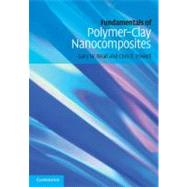
Note: Supplemental materials are not guaranteed with Rental or Used book purchases.
Purchase Benefits
Looking to rent a book? Rent Fundamentals of Polymer-Clay Nanocomposites [ISBN: 9780521876438] for the semester, quarter, and short term or search our site for other textbooks by Gary W. Beall , Clois E. Powell. Renting a textbook can save you up to 90% from the cost of buying.
| Introduction | p. 1 |
| Thermodynamics and kinetics of polymer-clay nanocomposites | p. 4 |
| Clay surface compatibility with polymers | p. 4 |
| Smectite clay structure | p. 4 |
| Turbostratic nature of smectite clays | p. 6 |
| Intercalation chemistry | p. 8 |
| Intercalation of water-soluble polymers | p. 9 |
| Hydrophobic intercalation | p. 12 |
| Intercalation via ion exchange | p. 12 |
| Alternative intercalation chemistries | p. 13 |
| Intercalation via ion-dipole bonding | p. 13 |
| Hydrophobic polymer intercalation | p. 16 |
| Edge treatment with silane coupling agents | p. 17 |
| Thermodynamics of polymer-clay interactions | p. 17 |
| The enthalpic role in exfoliation | p. 17 |
| The entropic role in exfoliation | p. 19 |
| Kinetics of intercalation-exfoliation | p. 19 |
| References | p. 20 |
| Analytical methods utilized in nanocomposites | p. 23 |
| Wide-angle X-ray diffraction | p. 23 |
| Transmission electron microscopy (Tem) | p. 27 |
| Scanning electron microscopy (Sem) | p. 31 |
| Atomic force microscopy (Afm) | p. 32 |
| Indirect methods | p. 32 |
| References | p. 33 |
| Gas diffusion characteristics of polymer-clay nanocomposites | p. 35 |
| Potential of polymer-clay nanocomposites as barrier materials | p. 35 |
| Models for gas transport in polymer-clay nanocomposites | p. 36 |
| The tortuous path model for barrier in nanocomposites | p. 36 |
| Experimental data on nanocomposite barrier performance | p. 38 |
| Data supporting the constrained polymer model | p. 44 |
| References | p. 46 |
| Engineering properties of polymer-clay nanocomposites theory and theory validation | p. 49 |
| Mechanics | p. 49 |
| Proper preparation and analysis of polymer-clay nanocomposites | p. 50 |
| Theory of anisotropic dispersed-phase reinforcement of polymers | p. 51 |
| Genesis: anisotropic dispersed-phase reinforcement of metal alloys | p. 51 |
| Transition from anisotropic dispersed-phase reinforcement in metal alloys to anisotropic dispersed-phase reinforcement in polymers | p. 53 |
| Validation of the morphology of montmorillonite as anisotropic dispersed-phase reinforcement in polymers | p. 55 |
| Refinement of the mechanism of montmorillonite reinforcement of polymers | p. 58 |
| Conclusions | p. 63 |
| References | p. 66 |
| Variables associated with polymer-clay processing in relation to reinforcement theory | p. 68 |
| The polymer as a significant independent variable in the mechanical performance of polymer-clay nanocomposites | p. 68 |
| Processing as a significant independent variable for polymer-clay nanocomposite preparation | p. 71 |
| Hydrophilic-hydrophobic balance of the surface of montmorillonite as a significant independent variable for polymer-clay nanocomposite preparation | p. 74 |
| Examination of the historical revelation of polymer-clay nanotechnology | p. 78 |
| Examination of polymer-clay composites with complex processing issues | p. 83 |
| Polymer chain engineering in relation to montmorillonite incorporation as a nanoparticle | p. 86 |
| Conclusions | p. 90 |
| References | p. 91 |
| The relationships of polymer type specificity to the production of polymer-clay nanocomposites | p. 95 |
| Complexity of polyolefin-montmorillonite nanocomposites | p. 95 |
| Difficulties associated with the preparation of polyimide-clay nanocomposites | p. 121 |
| The conundrum of polystyrene-clay nanocomposites | p. 124 |
| Mysteries associated with elastomer-clay nanocomposites | p. 130 |
| Dichotomy of crystalline and amorphous polyester-clay nanocornposites | p. 135 |
| Two-phase engineered polymer (polyurethane) synergy with clay nanocrnposite reinforcement | p. 140 |
| Elastomers that crosslink with clay nanocomposite reinforcement | p. 145 |
| Conclusions | p. 149 |
| References | p. 151 |
| Flame retardancy | p. 156 |
| Enhanced thermal stability provided by polymer-clay nanocomposites | p. 156 |
| Relationships between enhanced thermal stability of polymer-clay nanocomposites and flame retardancy | p. 165 |
| Evaluations of potential synergies between traditional flame retardants for polymers and polymer-clay nanocomposites | p. 174 |
| Summary and conclusions | p. 177 |
| References | p. 178 |
| Index | p. 183 |
| Table of Contents provided by Ingram. All Rights Reserved. |
The New copy of this book will include any supplemental materials advertised. Please check the title of the book to determine if it should include any access cards, study guides, lab manuals, CDs, etc.
The Used, Rental and eBook copies of this book are not guaranteed to include any supplemental materials. Typically, only the book itself is included. This is true even if the title states it includes any access cards, study guides, lab manuals, CDs, etc.